Class 7 Maths Chapter 2 Fractions and Decimals NCERT Solutions
- Class 7 Maths Fractions and Decimals Exercise 2.1
- Class 7 Maths Fractions and Decimals Exercise 2.2
- Class 7 Maths Fractions and Decimals Exercise 2.3
- Class 7 Maths Fractions and Decimals Exercise 2.4
- Class 7 Maths Fractions and Decimals Exercise 2.5
- Class 7 Maths Fractions and Decimals Exercise 2.6
- Class 7 Maths Fractions and Decimals Exercise 2.7
NCERT Solutions for Class 7 Maths Chapter 2 Fractions and Decimals Exercise 2.1
Ex 2.1 Class 7 Maths Question 1.
Solve: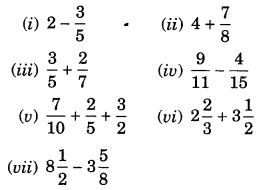
Solution: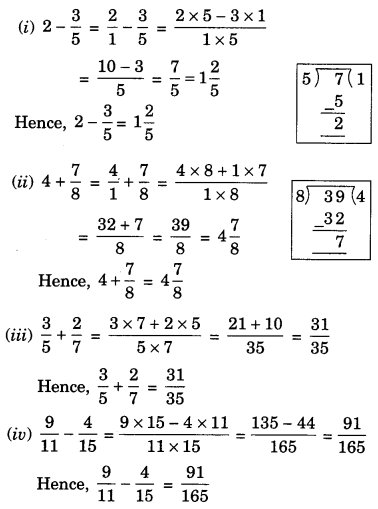
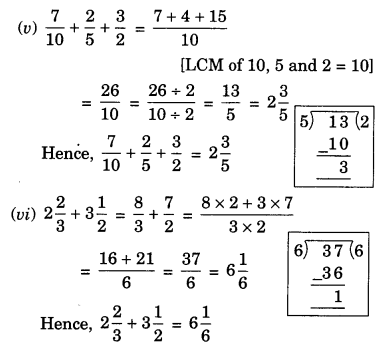
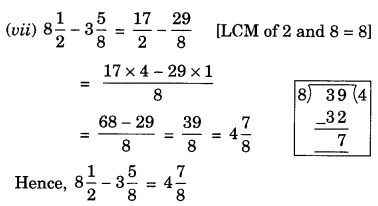
Ex 2.1 Class 7 Maths Question 2.
Arrange the following in descending order:
\((i) \frac{2}{9}, \frac{2}{3}, \frac{8}{21} \quad(i i) \frac{1}{5}, \frac{3}{7}, \frac{7}{10}\)
Solution: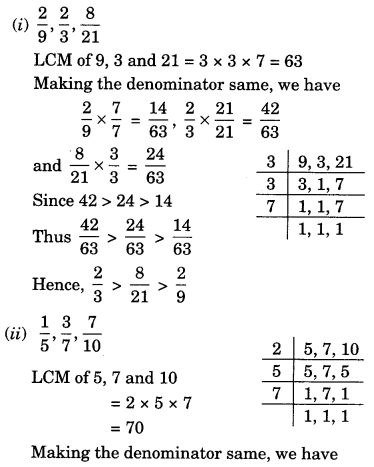
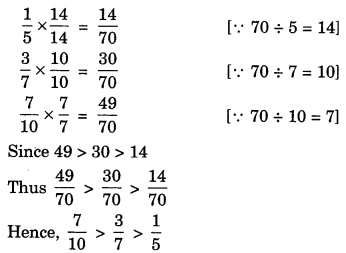
Ex 2.1 Class 7 Maths Question 3.
In a “magic square” the sum of number in each row, in each column and along the diagonals is the same. Is this a magic square?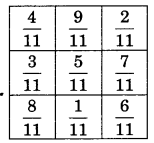
Solution: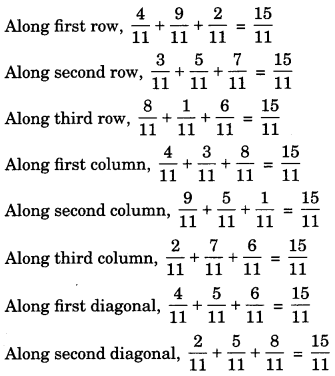
Since, the sum of all the fraction row wise, column wise and the diagonal wise is same i.e. \(\frac{15}{11}\).
Hence, it is a magic square.
Ex 2.1 Class 7 Maths Question 4.
A rectangular sheet of paper is \(12 \frac{1}{2}\) cm long and \(10 \frac{2}{3}\) cm wide. Find its perimeter.
Solution: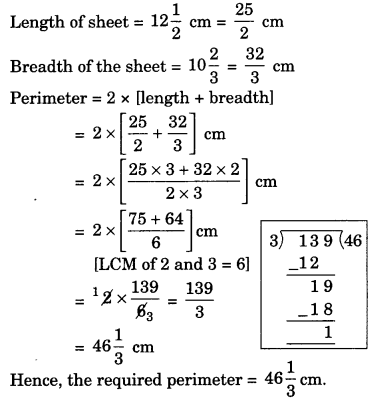
Ex 2.1 Class 7 Maths Question 5.
Find the perimeter of (i) ∆ABE (ii) the rectangle BCDE in this figure. Whose perimeter is greater?
Solution:
(i) Perimeter of ∆ABE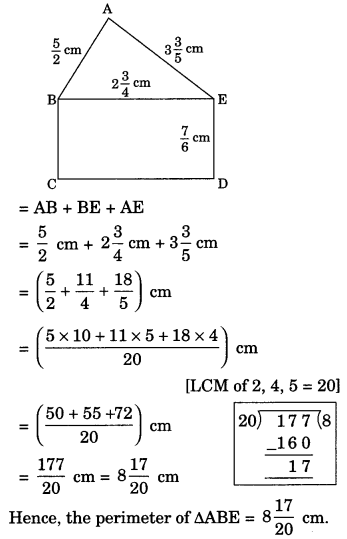
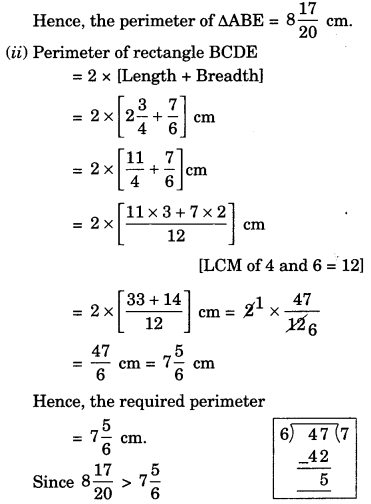
Thus perimeter of ∆ABE is greater than the perimeter of the rectangle BCDE.
Ex 2.1 Class 7 Maths Question 6.
Salil wants to put a picture in a frame. The picture is \(7 \frac{3}{5}\) cm wide. To fit in the frame, the picture cannot be more than \(7 \frac{3}{10}\) cm wide. How much should the picture be trimmed?
Solution:
The width of the picture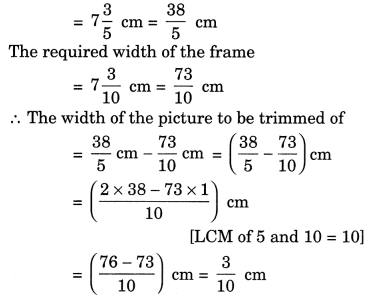
Hence, the required width to be trimmed \(=\frac{3}{10}\) cm.
Ex 2.1 Class 7 Maths Question 7.
Ritu ate \(=\frac{3}{5}\) part of an apple and the remaining apple was eaten by her brother Somu. How much part of the apple did Somu eat? Who had the larger share? By how much?
Solution:
Let the whole part of the apple be 1.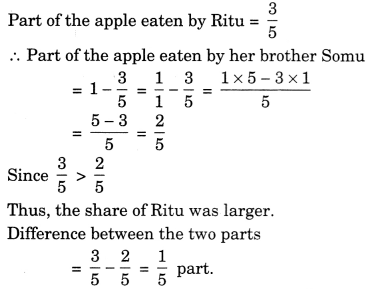
Ex 2.1 Class 7 Maths Question 8.
Michael finished colouring a picture in \(\frac{7}{12}\) hour. Vaibhav finished colouring the same picture in \(\frac{3}{4}\) hour. Who worked longer? By what fraction was it longer?
Solution:
Time taken by Michael = \(\frac{7}{12}\) hour
Time taken by Vaibhav = \(\frac{3}{4}\) hour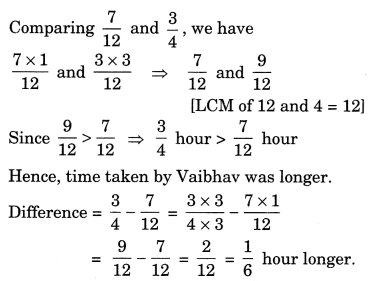
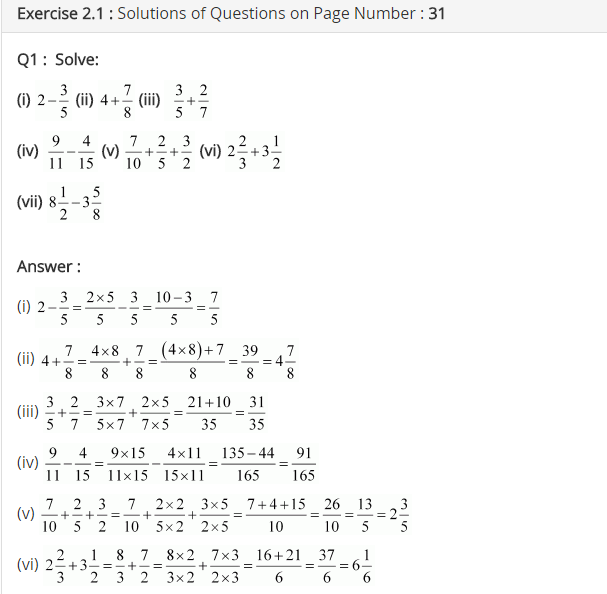
![]()
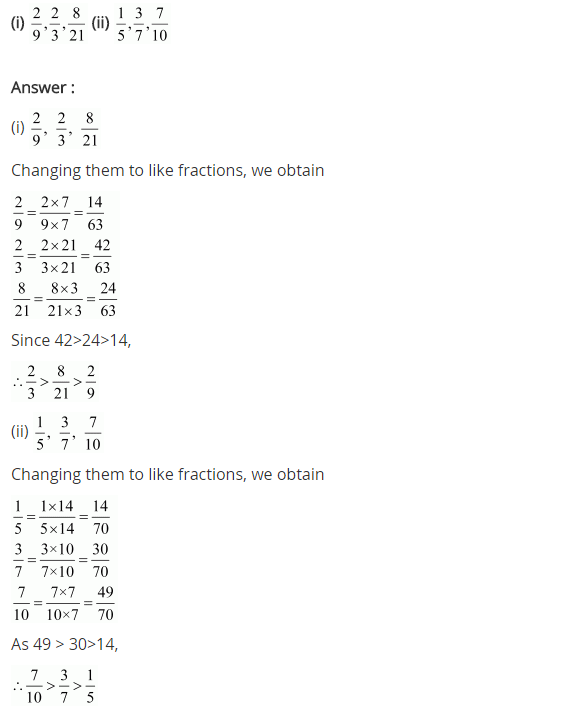
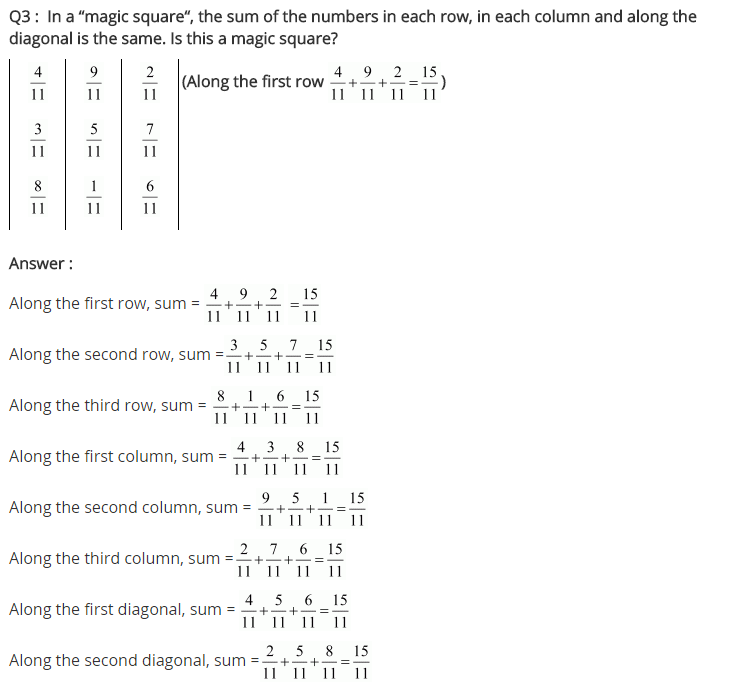
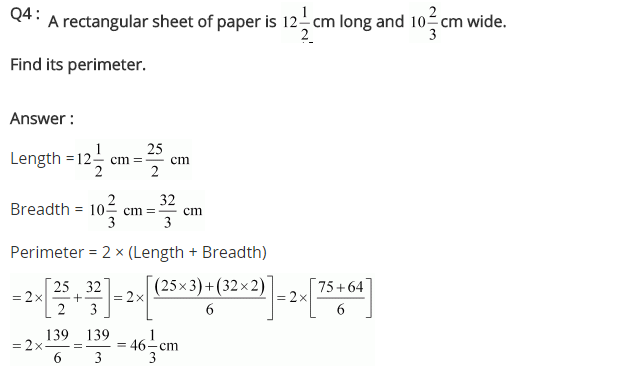
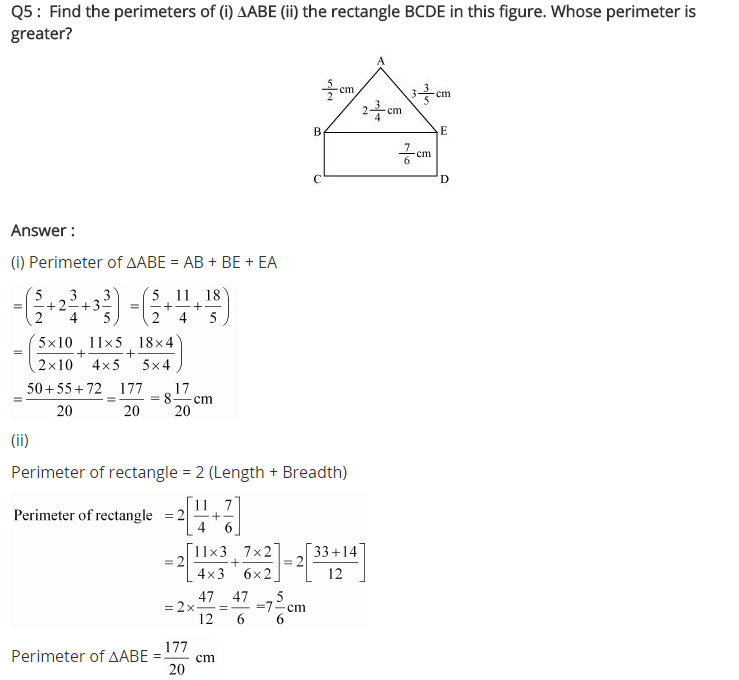
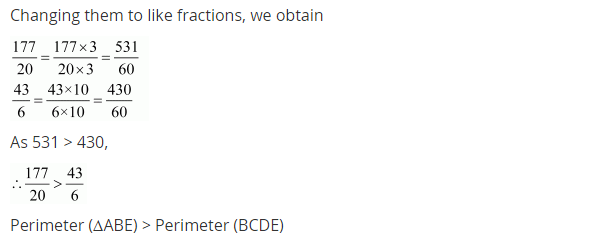
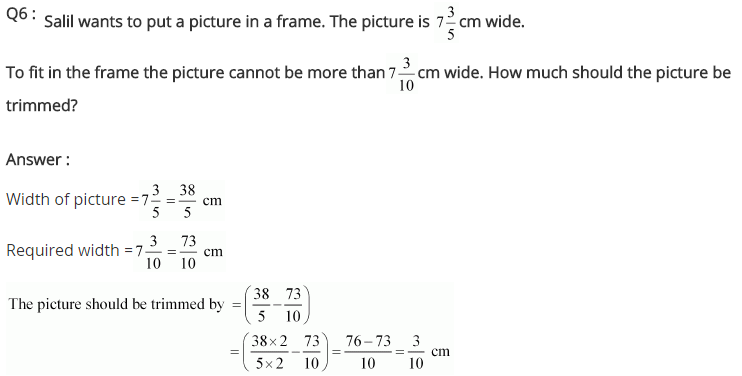
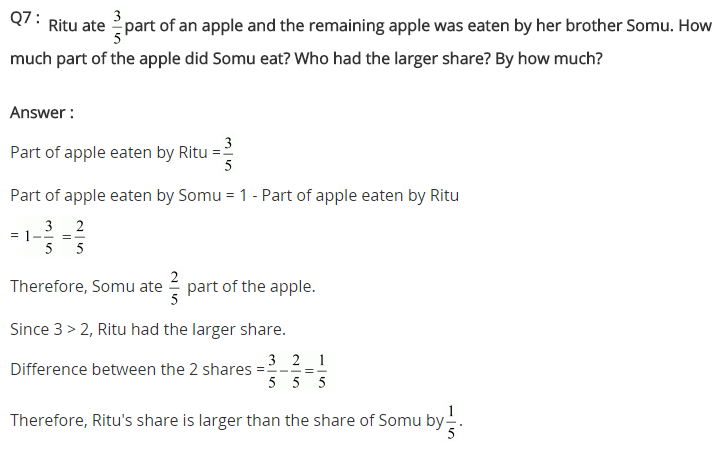
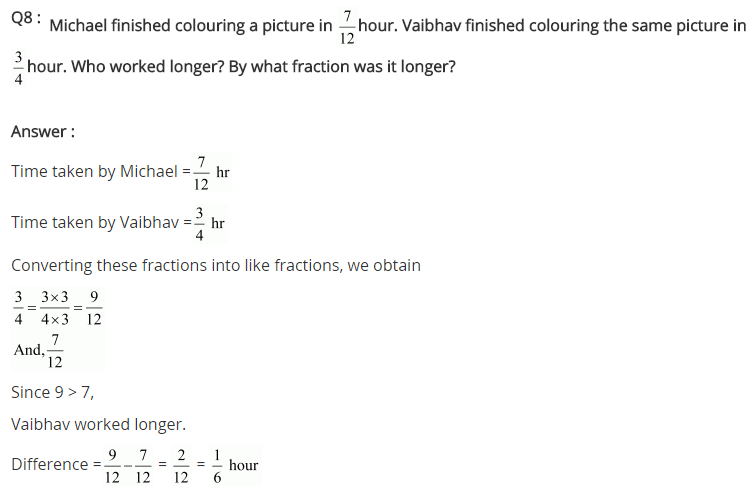
NCERT Solutions for Class 7 Maths Chapter 2 Fractions and Decimals Exercise 2.2
Ex 2.2 Class 7 Maths Question 1.
Which of the drawings (a) to (d) show.
\(\begin{array}{ll}{(i) 2 \times \frac{1}{5}} & {(i i) 2 \times \frac{1}{2}} \\ {(i i i) 3 \times \frac{2}{3}} & {(i v) 3 \times \frac{1}{4}}\end{array}\)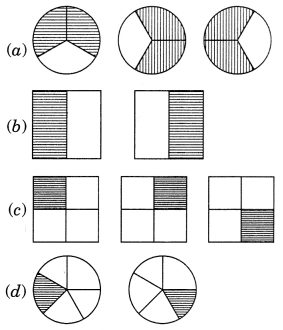
Solution:
(i) \(2 \times \frac{1}{5}\) represents drawing (d)
(ii) \(2 \times \frac{1}{2}\) represents drawing (b)
(iii) \(3 \times \frac{2}{3}\) represents drawing (a)
(ic) \(3 \times \frac{1}{4}\) represents drawing (c)
Ex 2.2 Class 7 Maths Question 2.
Some pictures (a) to (c) are given below. Tell which of them show: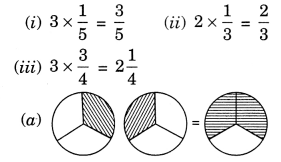

Solution:
(i) \(3 \times \frac{1}{5}=\frac{3}{5}\) represents figure (c)
(ii) \(2 \times \frac{1}{3}=\frac{2}{3}\) represents figure (a)
(iii) \(3 \times \frac{3}{4}=2 \frac{1}{4}\) represents figure (b)
Ex 2.2 Class 7 Maths Question 3.
Multiply and reduce to lowest form and convert into a mixed fraction: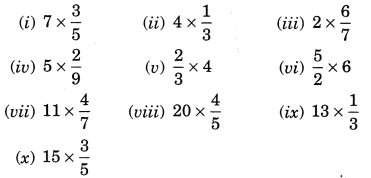
Solution: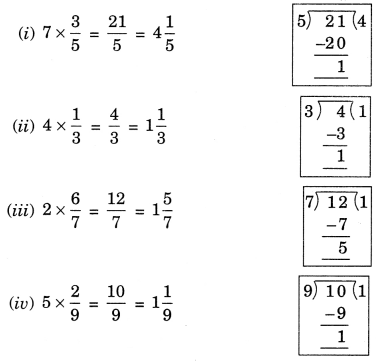
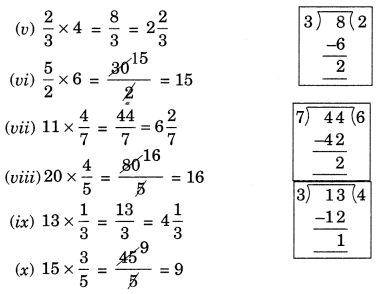
Ex 2.2 Class 7 Maths Question 4.
Shade:
(i) \(\frac{1}{2}\) of the circles in box (a)
(ii) \(\frac{2}{3}\) of the circles in box (b)
(iii) \(\frac{3}{5}\) of the circles in box (c)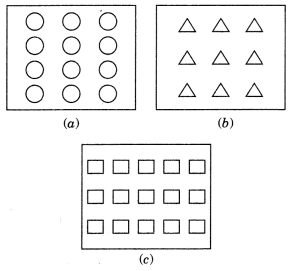
Solution: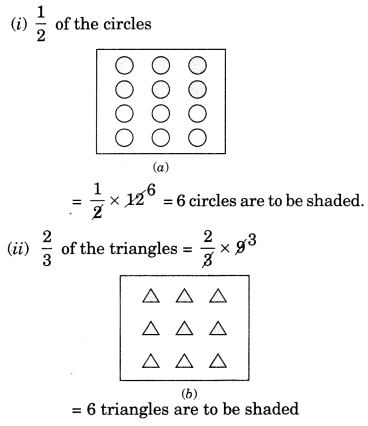
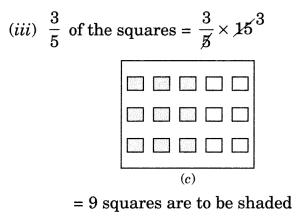
Ex 2.2 Class 7 Maths Question 5.
Find:
Solution: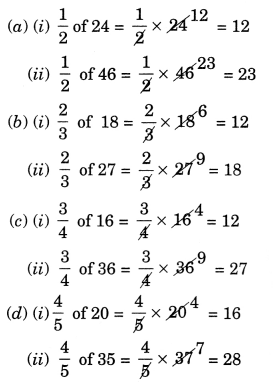
Ex 2.2 Class 7 Maths Question 6.
Multiply and express as a mixed fraction.
Solution: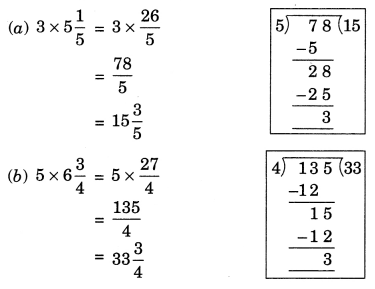
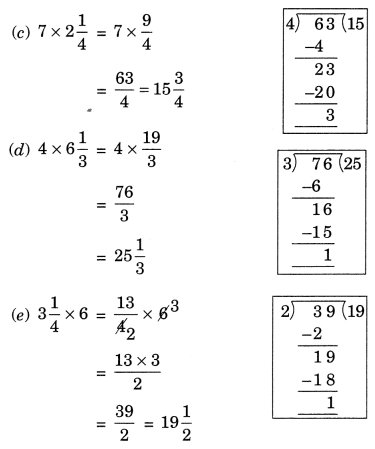
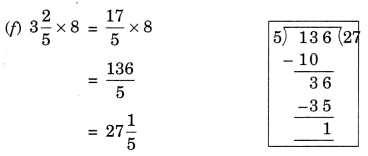
Ex 2.2 Class 7 Maths Question 7.
Find: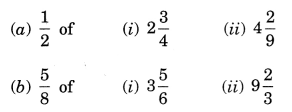
Solution: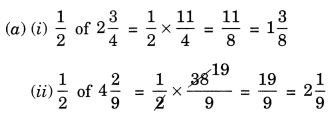
Ex 2.2 Class 7 Maths Question 8.
Vidya and Pratap went for a picnic. Their mother gave them a water bottle that contained 5 litres of water. Vidya consumed \(\frac{2}{5}\) of the water. Pratap consumed the remaining water.
(i) How much water did Vidya drink?
(ii) What fraction of the total quantity of water did Pratap drink?
Solution:
(i) Water consumed by Vidya = \(\frac{2}{5}\) of 5 litres![]()
Water consumed by Patap
= 5 litres – 2 litres = 3 litres
(ii) Fraction of water consumed by Pratap
= \(\frac{3}{5}\) litres
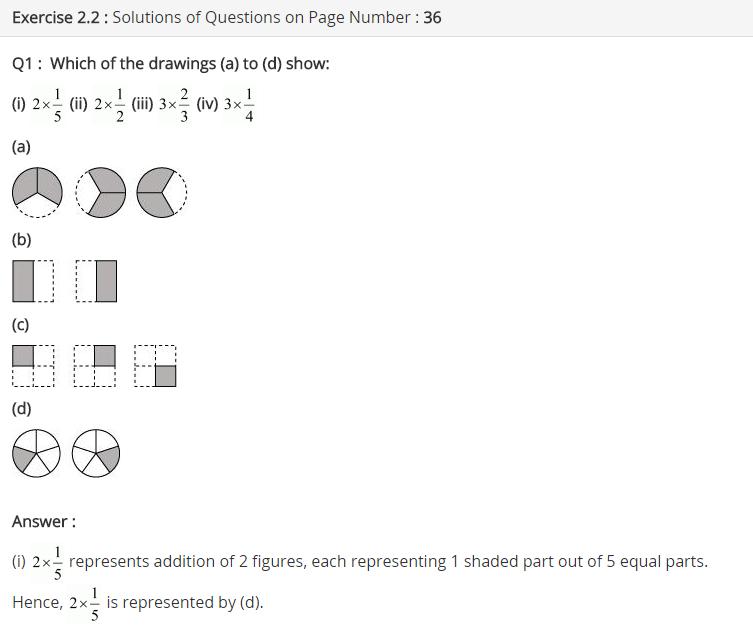
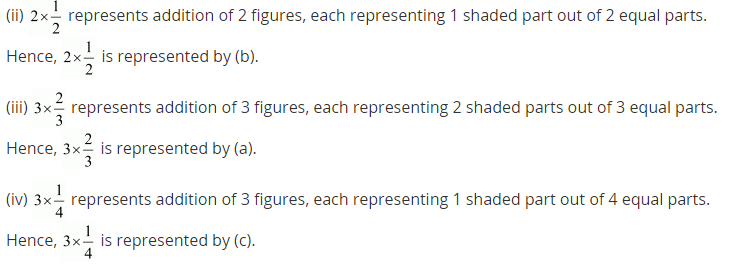
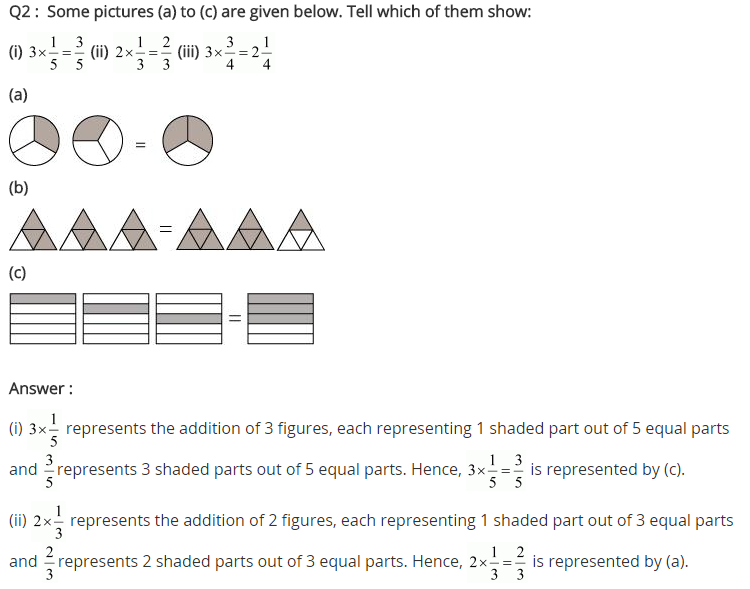

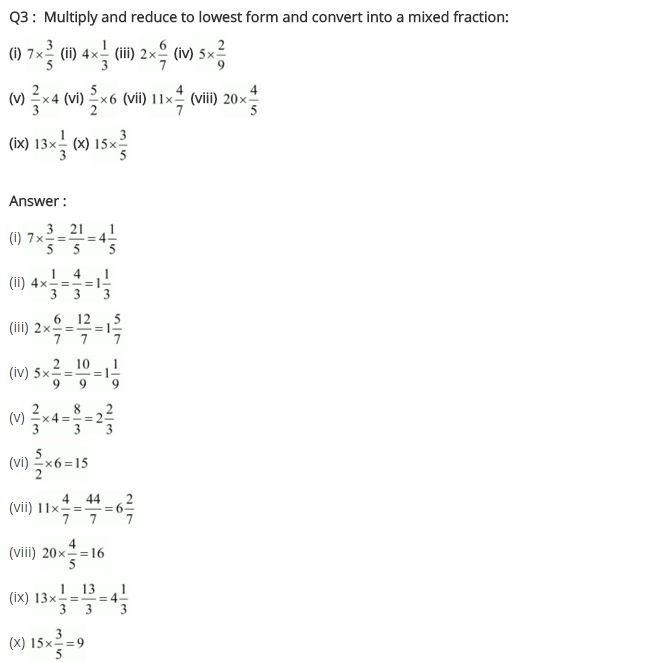
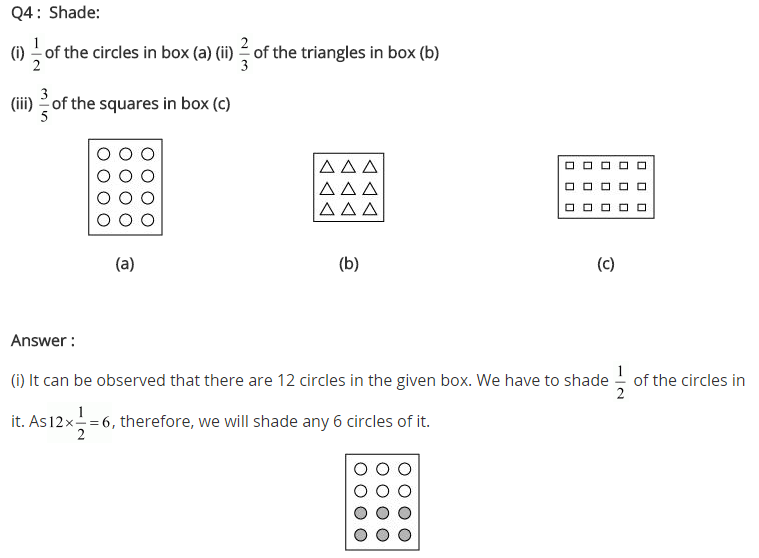
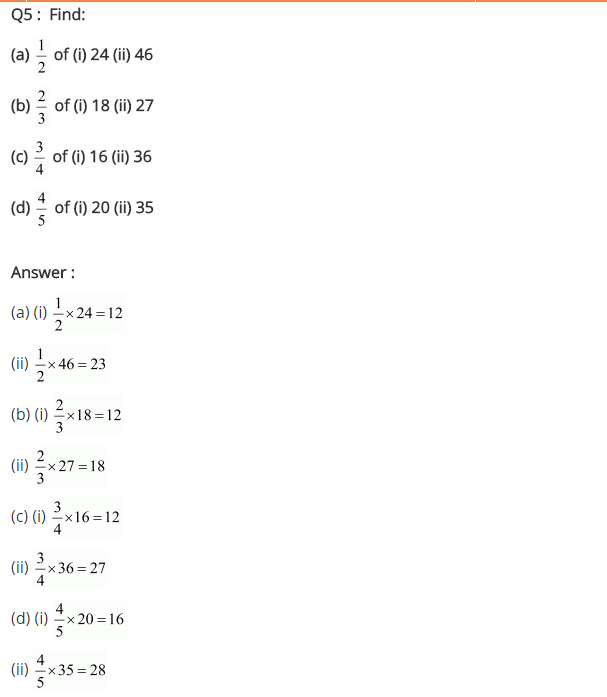
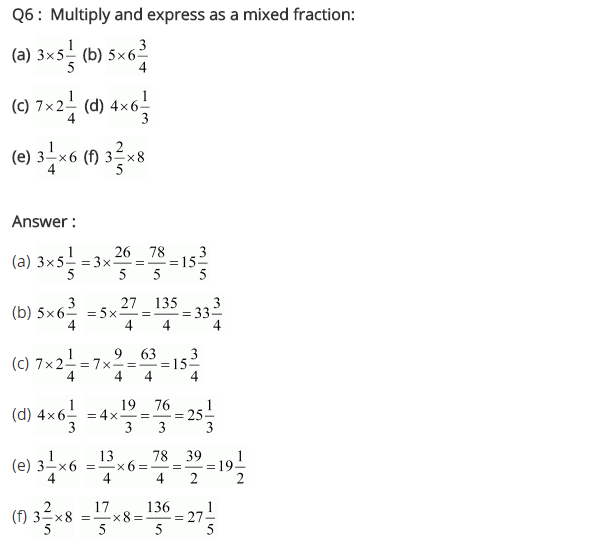
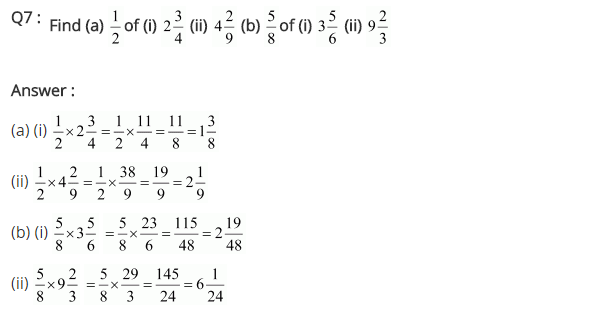
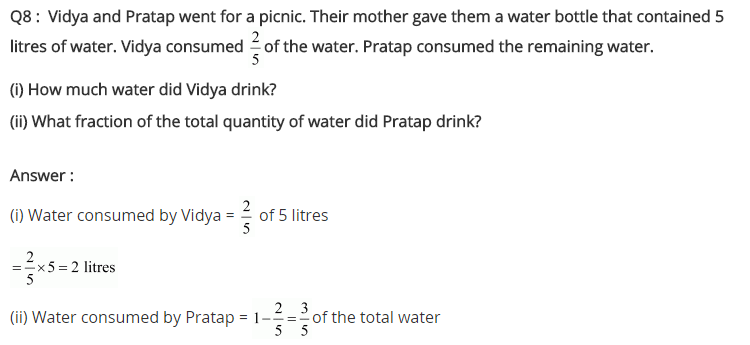
NCERT Solutions for Class 7 Maths Chapter 2 Fractions and Decimals Exercise 2.3
Ex 2.3 Class 7 Maths Question 1.
Find:
Solution: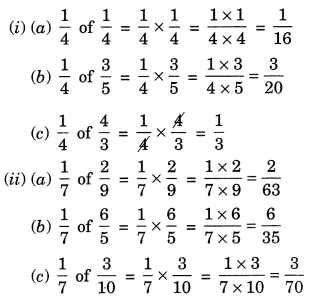
Ex 2.3 Class 7 Maths Question 2.
Multiply and reduce to lowest form (if possible):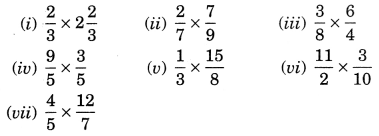
Solution: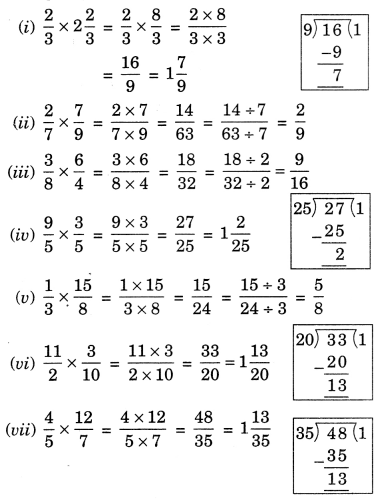
Ex 2.3 Class 7 Maths Question 3.
Multiply the following fractions: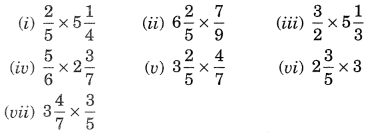
Solution: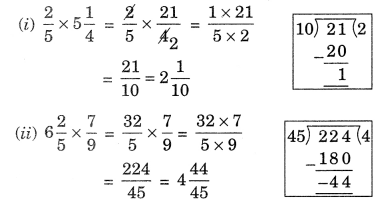
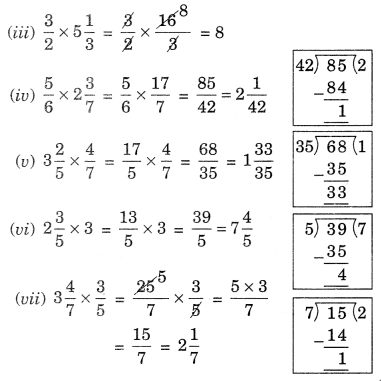
Ex 2.3 Class 7 Maths Question 4.
Which is greater:![]()
Solution: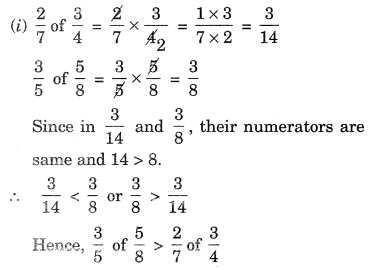
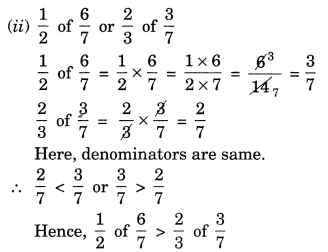
Ex 2.3 Class 7 Maths Question 5.
Saili plants 4 saplings, in a row, in her garden. The distance between two adjacent saplings is \(\frac{3}{4}\) m. Find the distance between the first and the last sapling.
Solution:
Number of saplings = 4
Distance between two adjacent saplings = \(\frac{3}{4}\) m
∴ Distance between the first and the last sapling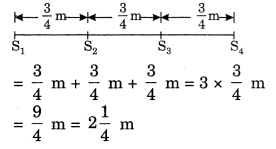
Ex 2.3 Class 7 Maths Question 6.
Lipika reads a book for \(1 \frac{3}{4}\) hours everyday. She reads the entire book in 6 days. How many hours in all were required by her to read the book?
Solution:
In 1 day Lipika needs \(1 \frac{3}{4}\) hours
In 6 days Lipika will need \(6 \times 1 \frac{3}{4}\) hours
Hence the required hours = \(10 \frac{1}{2}\).
Ex 2.3 Class 7 Maths Question 7.
A car runs 16 km using 1 litre of petrol. How much distance will it cover using \(2 \frac{3}{4}\) litres of petrol?
Solution:
In 1 litre of petrol, the car covers 16 km distance In \(2 \frac{3}{4}\) litres of petrol, the car will cover \(2 \frac{3}{4}\) × 16 km distance
Hence, the required distance = 44 km.
Ex 2.3 Class 7 Maths Question 8.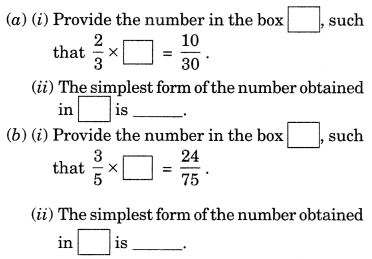
Solution: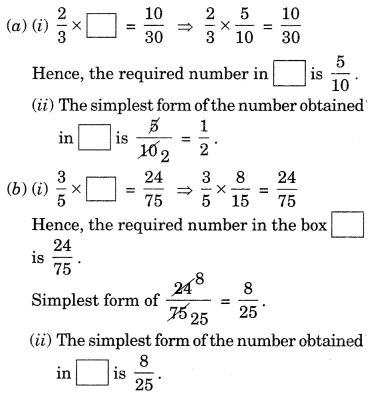
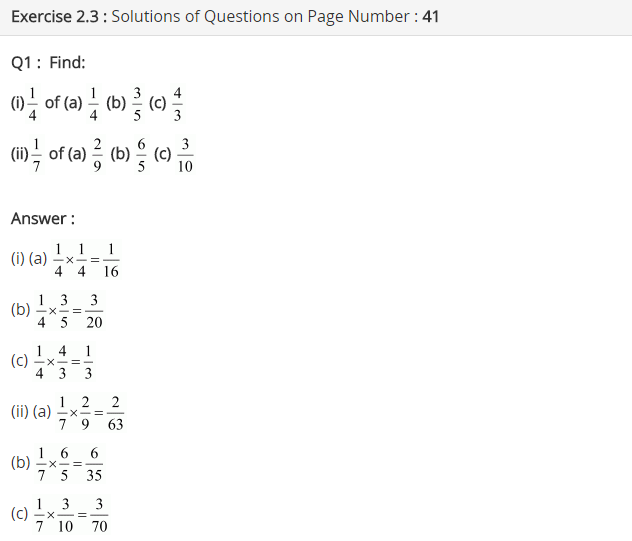
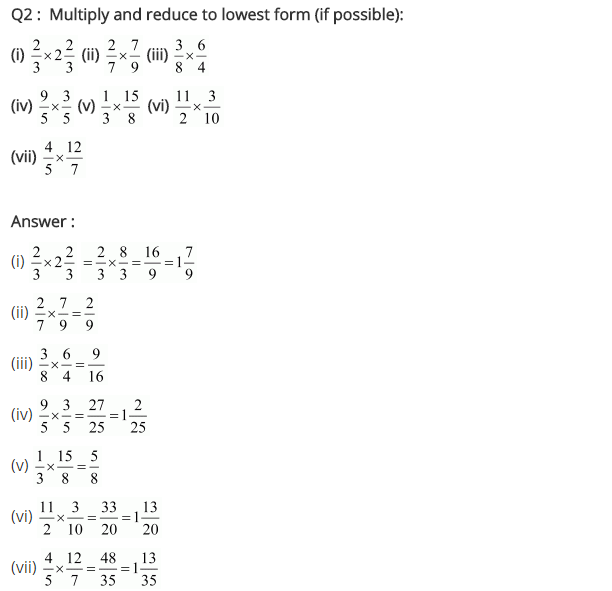
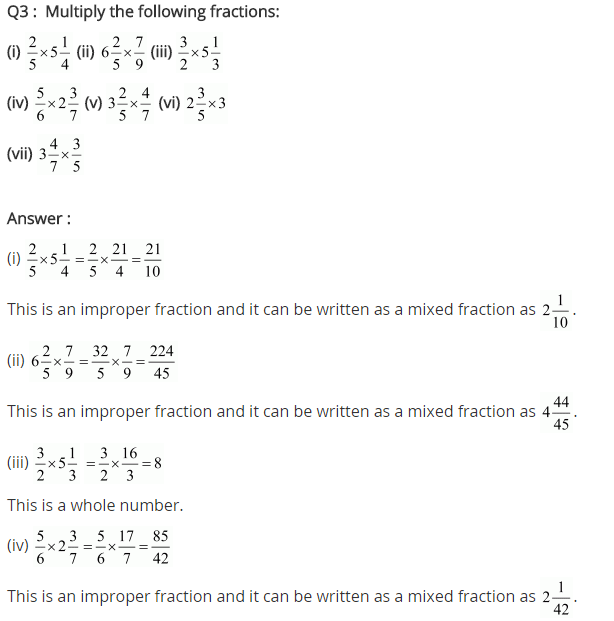
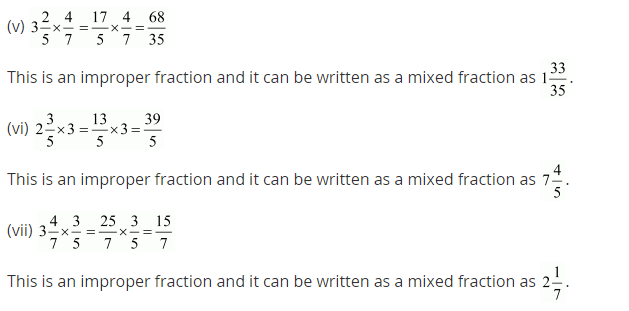
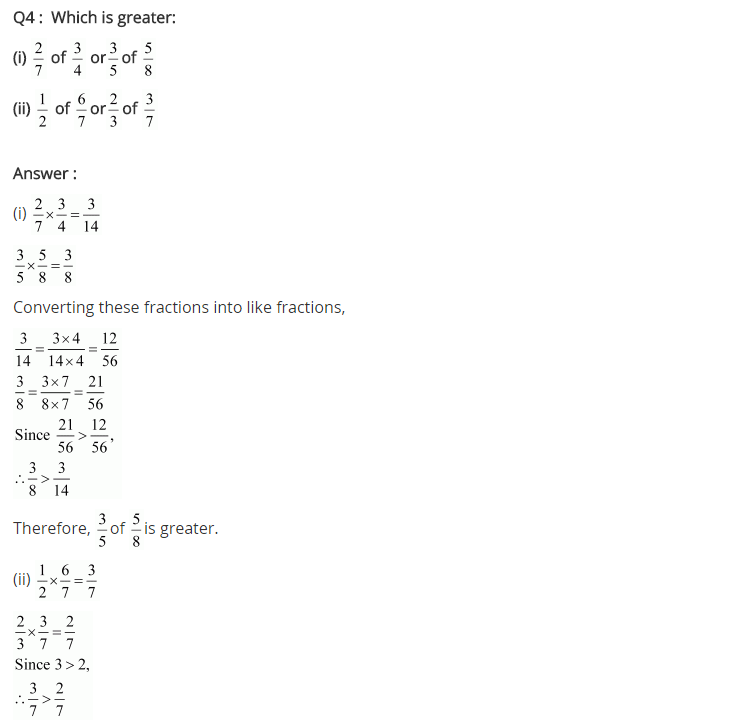
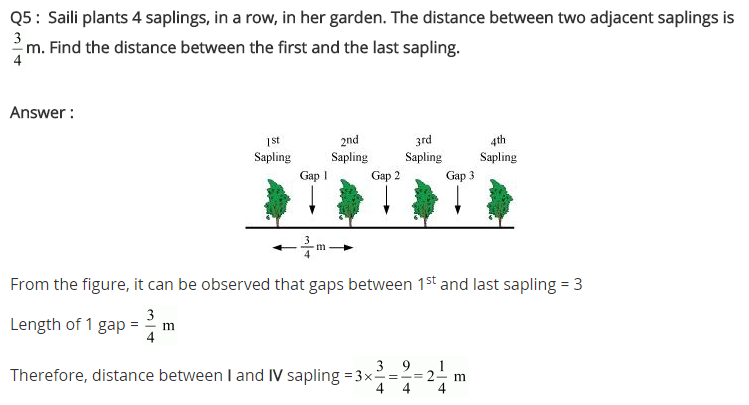
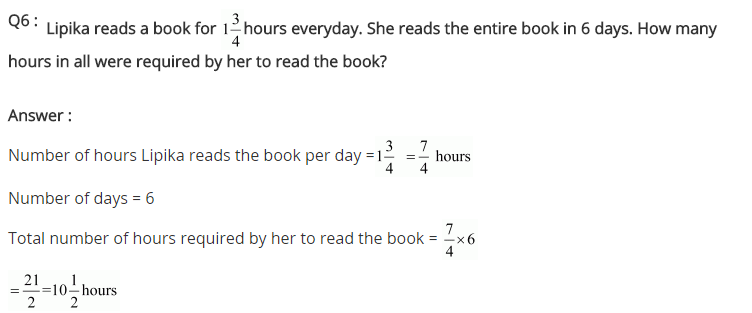
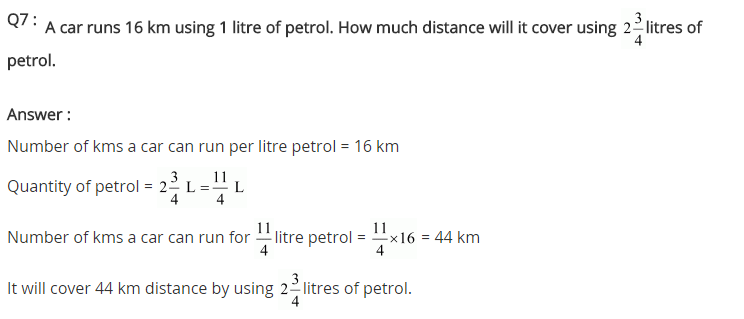
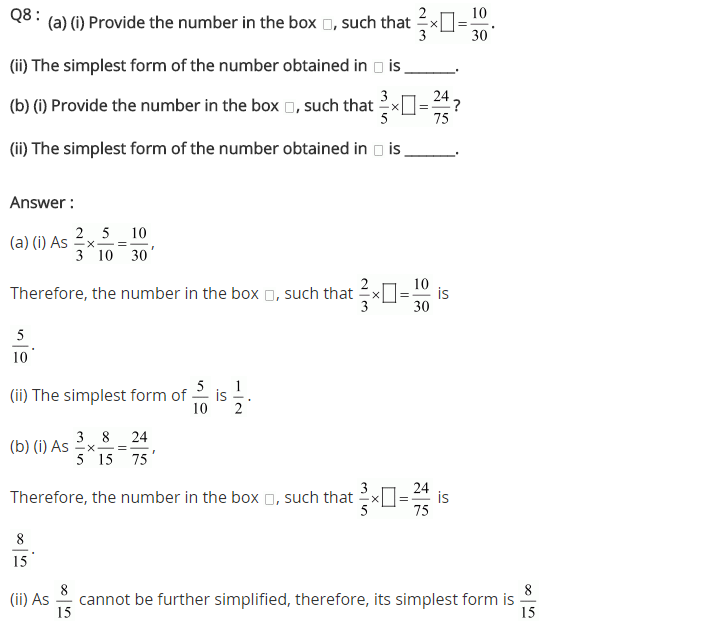
NCERT Solutions for Class 7 Maths Chapter 2 Fractions and Decimals Exercise 2.4
Ex 2.4 Class 7 Maths Question 1.
Find:
Solution: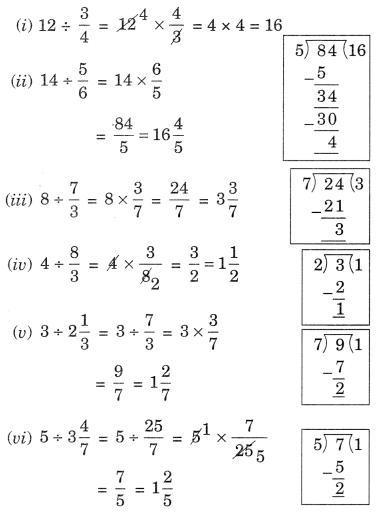
Ex 2.4 Class 7 Maths Question 2.
Find the reciprocal of each of the following fractions. Classify the reciprocals as proper fractions, improper fractions and whole numbers.
(i) Reciprocal of \(\frac{3}{7}=\frac{7}{3}\), which is improper fraction.
(ii) Reciprocal of \(\frac{5}{8}=\frac{8}{5}\), which is improper fraction.
(iii) Reciprocal of \(\frac{9}{7}=\frac{7}{9}\), which is proper fraction.
(iv) Reciprocal of \(\frac{6}{5}=\frac{5}{6}\), which is proper fraction.
(vi) Reciprocal of \(\frac{12}{7}=\frac{7}{12}\), which is proper fraction.
(vi) Reciprocal of \(\frac{1}{8}=8\), which is whole number.
(vii) Reciprocal of \(\frac{1}{11}=11\), which is whole number.
Ex 2.4 Class 7 Maths Question 3.
Find:
Solution: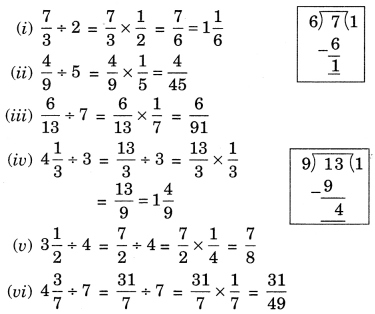
Ex 2.4 Class 7 Maths Question 4.
Find:

Solution:
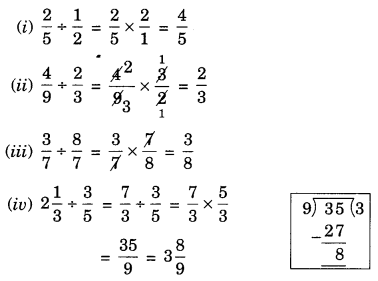
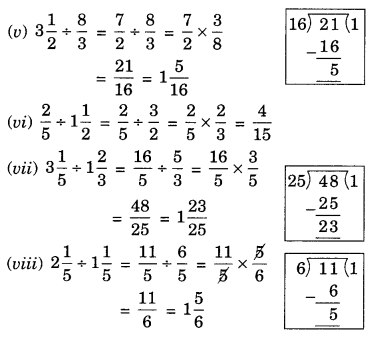
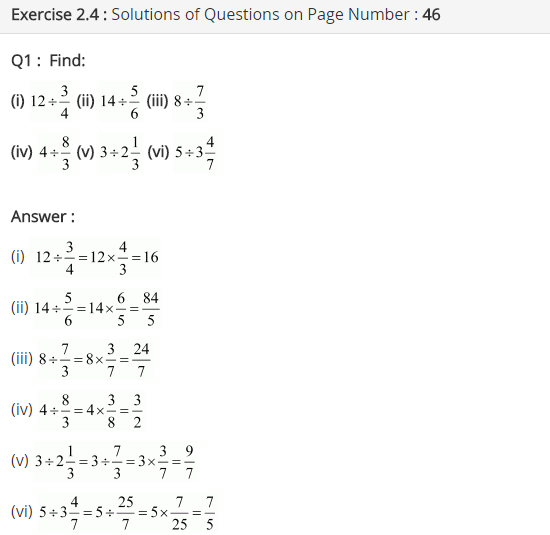
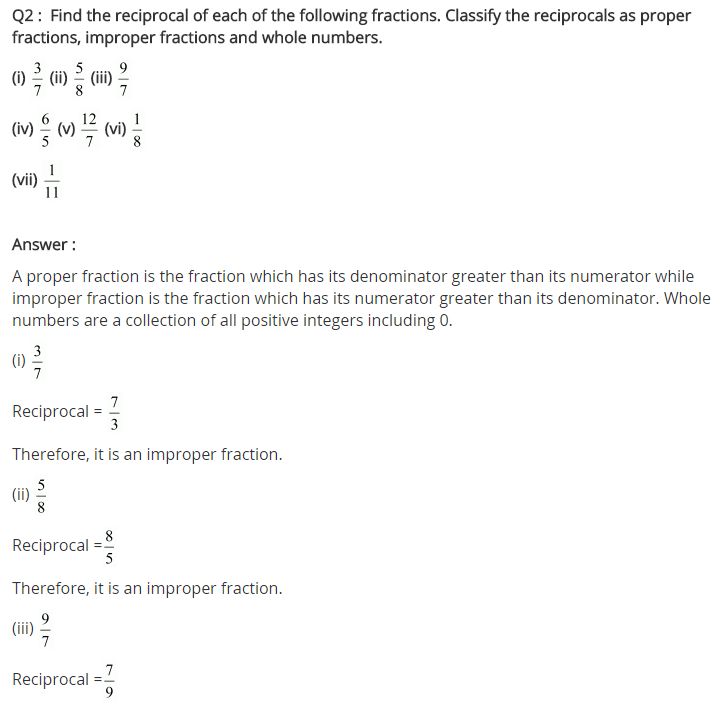
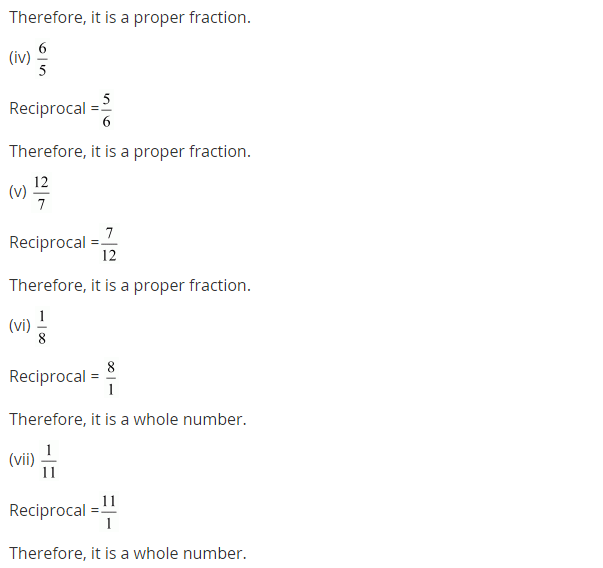
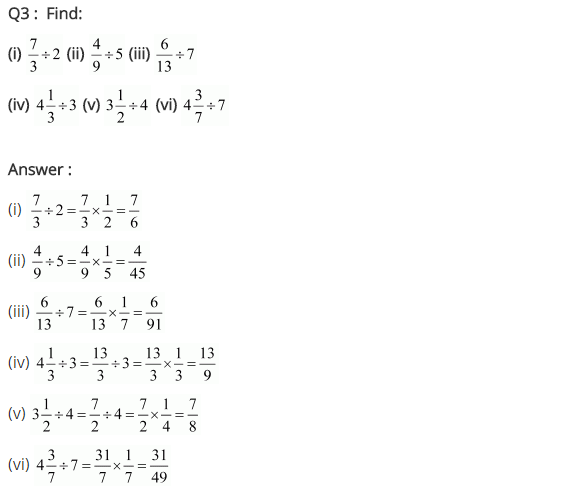
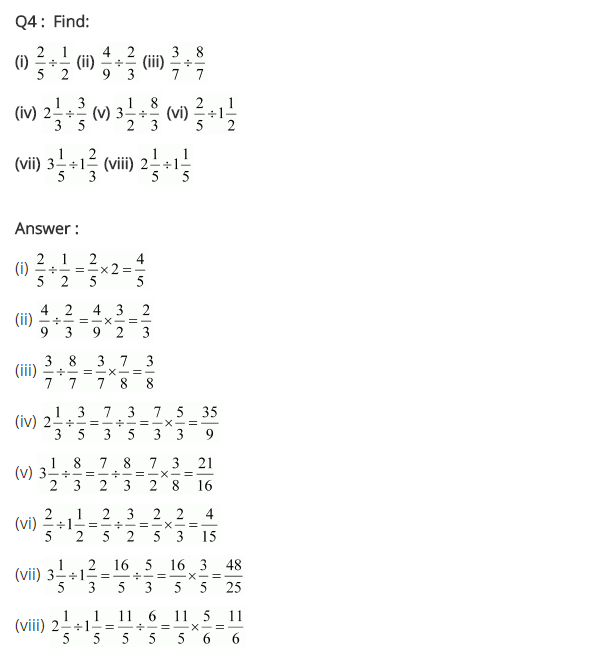
NCERT Solutions for Class 7 Maths Chapter 2 Fractions and Decimals Exercise 2.5
Ex 2.5 Class 7 Maths Question 1.
Which is greater?
(i) 0.5 or 0.05
(ii) 0.7 or 0.5
(iii) 7 or 0.7
(iv) 1.37 or 1.49
(v) 2.03 or 2.30
(vi) 0.8 or 0.88
Solution:
(i) 0.5 or 0.05
Comparing the tenths place, we get 5 > 0
∴ 0.5 > 0.05
(ii) 0.7 or 0.5
Comparing the tenths place, we get 7 > 5
∴ 0.7 > 0.5
(iii) 7 or 0.7
Comparing the one’s place, we get 7 > 0
∴ 7 > 0.7
(iv) 1.37 or 1.49
Comparing the tenths place, we get 3 < 4
∴ 1.37 < 1.49 or 1.49 > 1.37
(v) 2.03 or 2.30
Comparing the tenths place, we get 0 < 3
∴ 2.03 < 2.30 or 2.30 > 2.03
(vi) 0.8 or 0.88 ⇒ 0.80 or 0.88
Since tenths place is same.
Comparing the hundredth place, we get 0 < 8
∴ 0.80 < 0.88 or 0.88 > 0.80
Ex 2.5 Class 7 Maths Question 2.
Express as rupees using decimals:
(i) 7 paise
(ii) 7 rupees 7 paise
(iii) 77 rupees 77 paise
(iv) 50 paise
(v) 235 paise
Solution:
(i) Since 1 rupee = 100 paise and 1 paise = \(\frac{1}{100}\) rupees
7 paise =\(\frac{7}{100}\) rupees = 0.07 rupees
(ii) 7 rupees 7 paise = 7 rupees + \(\frac{7}{100}\) rupees
= 7.07 rupees
(iii) 77 rupees 77 paise = 77 rupees + \(\frac{77}{100}\) rupees
= 77.77 rupees
(iv) 50 paise = \(\frac{50}{100}\) rupees = 0.50 rupees
(v) 235 paise = \(\frac{235}{100}\) rupees = 2.35 rupees
Ex 2.5 Class 7 Maths Question 3.
(i) Express 5 cm in metre and kilometre
(ii) Express 35 mm in cm, m and km.
Solution:
(i) 1 metre = 100 cm
1 kilometre = 1000 metre = 100 × 1000 cm
= 100000 cm
∴ 5 cm = \(\frac{5}{100}\) metre = 0.05 metre
5 cm = \(\frac{5}{100000}\) km = 0.00005 km
Hence, 5 cm = 0.05 m and 0.00005 km
(ii) 1 cm = 10 mm and 1 km = 100000 cm
∴ 35 mm = \(\frac{35}{10}\) cm = 3.5 cm,
35 mm = \(\frac{35}{1000}\) m = 0.035 m
35 mm = \(\frac{35}{1000000}\) km = 0.000035 km
Hence, 35 mm = 3.5 cm, 0.035 m and 0.000035 km.
Ex 2.5 Class 7 Maths Question 4.
Express in kg:
(i) 200 g
(ii) 3470 g
(iii) 4 kg 8 g
Solution:
(i) 200g = \(\frac{200}{1000}\) kg [∵ 1 kg = 1000g]
= 0.2 kg
(ii) 3470 g = \(\frac{3470}{10000}\) = 3.47 kg [∵ 1 kg = 1000 g]
(iii) 4 kg 8 g = 4 kg + \(\frac{8}{10000}\)kg [∵ 1 kg = 1000 g]
= 4 kg + 0.008 kg = 4.008 kg
Ex 2.5 Class 7 Maths Question 5.
Write the following decimal numbers in the expanded form:
(i) 20.03
(ii) 2.03
(iii) 200.03
(iv) 2.034
Solution:
(i) 20.03 = 2 × 10 + 0 × 1 + 0 × \(\frac{1}{10}\) + 3 × \(\frac{1}{100}\)
(ii) 2.03 = 2 × 1 + 0 × \(\frac{1}{10}\) + 3 × \(\frac{1}{100}\)
(iii) 200.03 = 2 × 100 + 0 × 10 + 0 × 1 + 0 × \(\frac{1}{10}\) +3 × \(\frac{1}{100}\)
(iv) 2.034 = 2 × 1 + 0 × \(\frac{1}{10}\) + 3 × \(\frac{1}{10}\) + 4 × \(\frac{1}{1000}\)
Ex 2.5 Class 7 Maths Question 6.
Write the place value of 2 in the following decimal numbers:
(i) 2.56
(ii) 21.37
(iii) 10.25
(iv) 9.42
(v) 63.352
Solution:
(i) Place value of 2 in 2.56 = 2 × 1 = 2 i.e. ones
(ii) Place value of 2 in 21.37 = 2 × 10 = 20 i.e. tens
(iii) Place value of 2 in 10.25 = \(\frac{2}{10}\) = 0.2 i.e. tenths
(iv) Place value of 2 in 9.42 = \(\frac{2}{100}\) = 0.02 i.e. hundredths
(v) Place value of 2 in 63.352 = \(\frac{2}{1000}\) = 0.002 i.e. thousandths.
Ex 2.5 Class 7 Maths Question 7.
Dinesh went from place A to place B and from there to place C. A is 7.5 km from B and B is 12.7 km from C. Ayub went from place A to place D and from there to place C. D is 9.3 km from A and C is 11.8 km from D. Who travelled more and by how much?
Solution:
Distance travelled by Dinesh from A to C
= AB + BC
= 7.5 km +- 12.7 km
= 20.2 km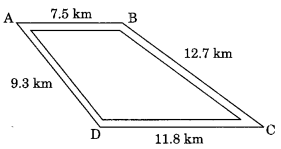
Distance travelled by Ayub from A to C
= AD + DC
= 9.3 km + 11.8 km = 21.1 km
Since 21.1 km > 20.2 km.
Hence, Ayub travelled more distance.
Ex 2.5 Class 7 Maths Question 8.
Shyama bought 5 kg 300 g apples and 3 kg 250 g mangoes. Sarala bought 4 kg 800 g oranges and 4 kg 150 g bananas. Who bought more fruits?
Solution:
Fruits bought by Shyama
= 5 kg 300 g apples + 3 kg 250 g mangoes
= 5.300 kg apples + 3.250 kg mangoes
= 8.550 kg of fruits
Fruits bought by Sarala
= 4 kg 800 g oranges +- 4 kg 150 g bananas
= 4.800 kg oranges + 4.150 kg bananas
= 8.950 kg of fruits
Since 8.950 kg > 8.550 kg
Hence, Sarala bought more fruits.
Ex 2.5 Class 7 Maths Question 9.
How much less is 28 km than 42.6 km?
Solution:
Since 28 km < 42.6 km
Hence, 28 km is less than 42.6 km by 14.6 km.
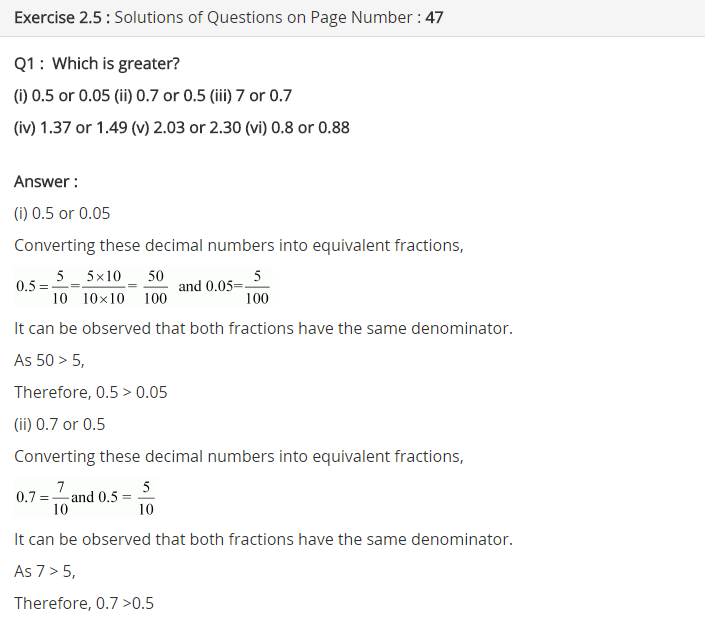
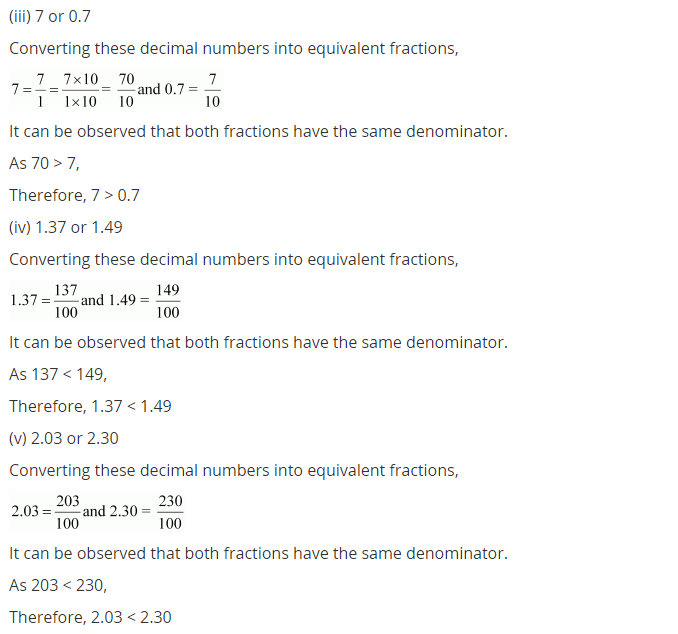

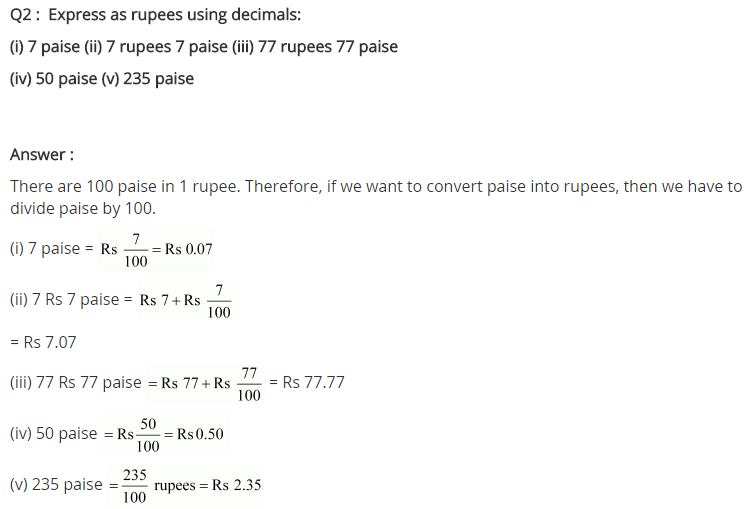
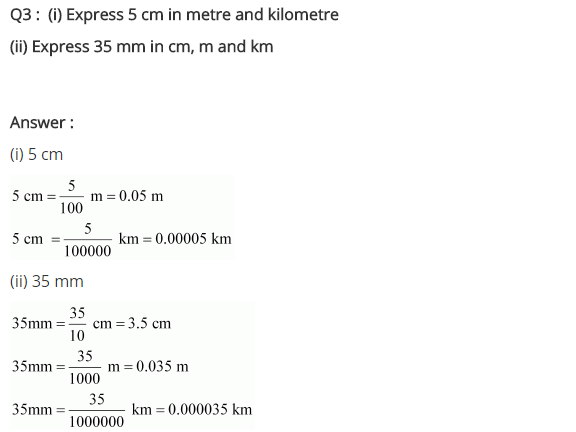
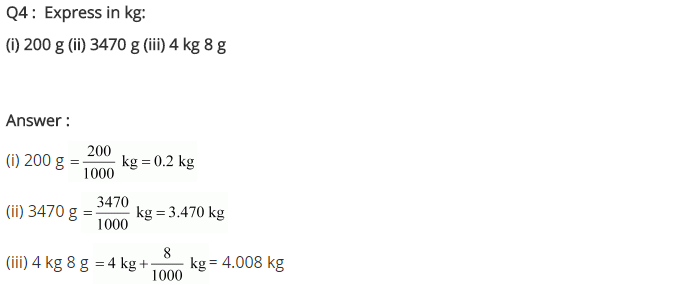
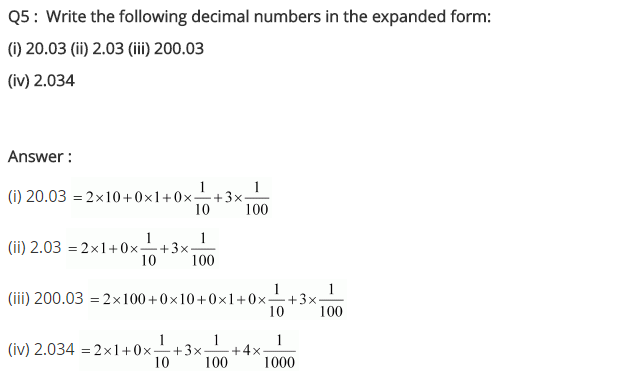
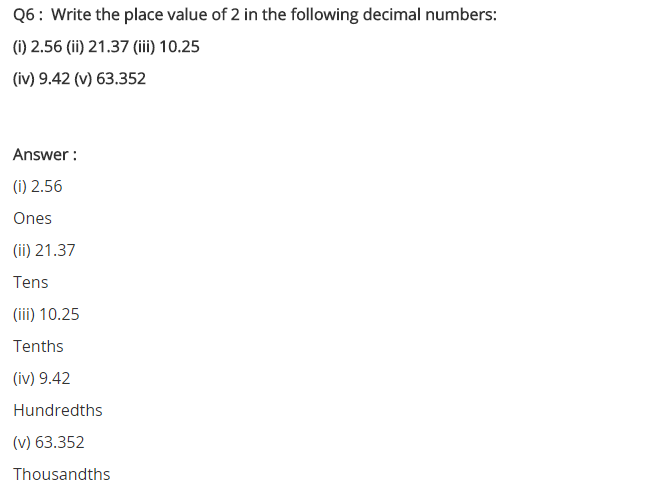
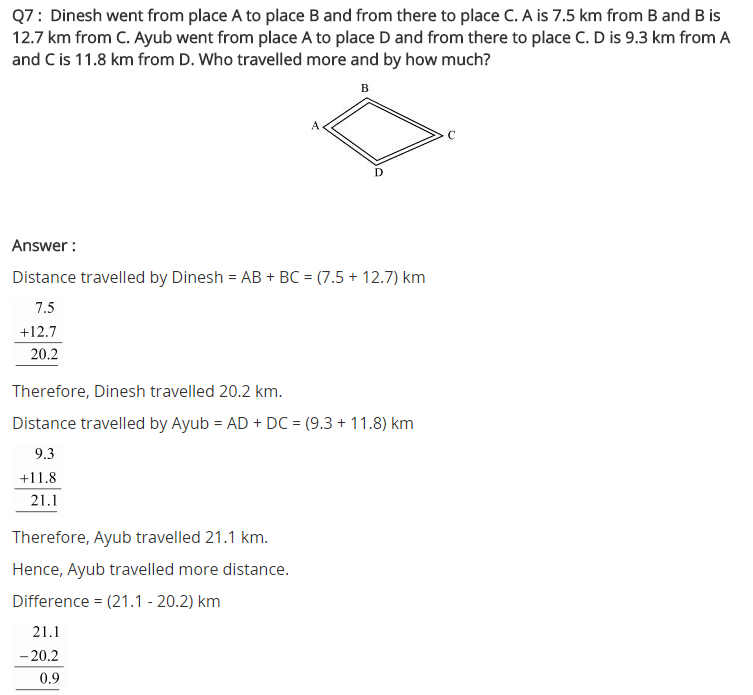
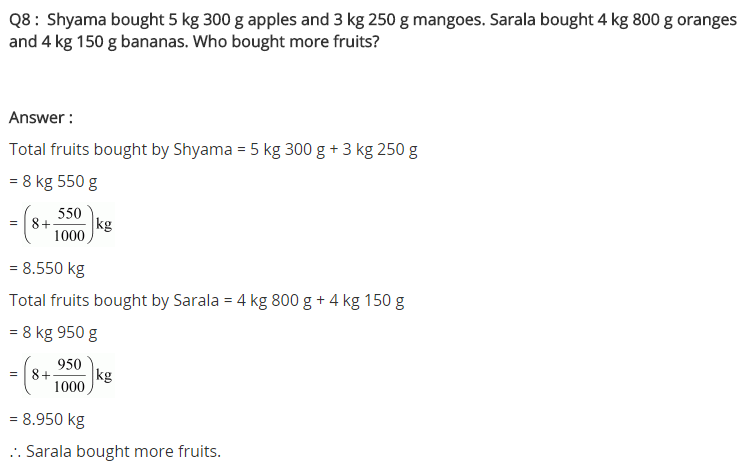

NCERT Solutions for Class 7 Maths Chapter 2 Fractions and Decimals Exercise 2.6
Ex 2.6 Class 7 Maths Question 1.
Find:
(i) 0.2 × 6
(ii) 8 × 4.6
(iii) 2.71 × 5
(iv) 20.1 × 4
(v) 0.05 × 7
(vi) 211.02 × 4
(vii) 2 × 0.86
Solution:
(i) 0.2 × 6
∵ 2 × 6 = 12 and we have 1 digit right to the decimal point in 0.2.
Thus 0.2 × 6 = 1.2
(ii) 8 × 4.6
∵ 8 × 46 = 368 and there is one digit right to the decimal point in 4.6.
Thus 8 × 4.6 = 36.8
(iii) 2.71 × 5
∵ 271 × 5 = 1355 and there are two digits right to the decimal point in 2.71.
Thus 2.71 × 5 = 13.55
(iv) 20.1 × 4
∵ 201 × 4 = 804 and there is one digit right to the decimal point in 20.1.
∵ 20.1 × 4 = 80.4
(v) 0.05 × 7
∵ 5 × 7 = 35 and there are 2 digits right to the decimal point in 0.05.
Thus 0.05 × 7 = 0.35
(vi) 211.02 × 4
∵ 21102 × 4 = 84408 and there are 2 digits right to the decimal point in 211.02.
Thus 211.02 × 4 = 844.08
(vii) 2 × 0.86
∵ 2 × 86 = 172 and there are 2 digits right to the decimal point in 0.86.
Thus 2 × 0.86 = 1.72
Ex 2.6 Class 7 Maths Question 2.
Find the area of rectangle whose length is 5.7 cm and breadth is 3 cm.
Solution:
Length = 5.7 cm
Breadth = 3 cm
Area of rectangle = length × breadth
= 5.7 × 3 = 17.1 cm2
Hence, the required area =17.1 cm2
Ex 2.6 Class 7 Maths Question 3.
Find:
(i) 1.3 × 10
(ii) 36.8 × 10
(iii) 153.7 × 10
(iv) 168.07 × 10
(v) 31.1 × 100
(vi) 156.1 × 100
(vii) 3.62 × 100
(viii) 43.07 × 100
(ix) 0.5 × 10
(x) 0.08 × 10
(xi) 0.9 × 100
(xii) 0.03 × 1000
Solution: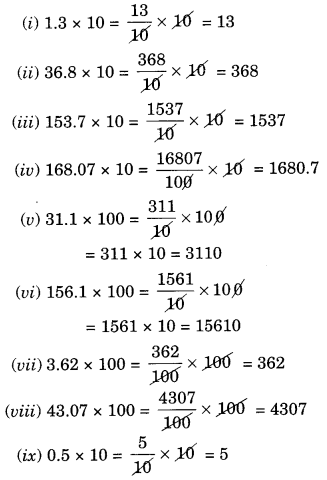
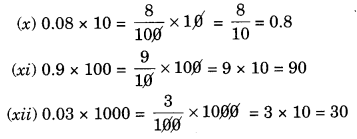
Ex 2.6 Class 7 Maths Question 4.
A two-wheeler covers a distance of 55.3 km in one litre of petrol. How much distance will it cover is 10 litres of petrol?
Solution:
Distance covered in 1 litre = 55.3 km
Distance covered in 10 litres = 55.3 × 10 km![]()
Hence, the required distance = 553 km
Ex 2.6 Class 7 Maths Question 5.
Find:
(i) 2.5 ×0.3
(ii) 0.1 × 51.7
(iii) 0.2 × 316.8
(iv) 1.3 × 3.1
(v) 0.5 × 0.05
(vi) 11.2 × 0.15
(vii) 1.07 × 0.02
(viii) 10.05 × 1.05
(ix) 100.01 × 1.1
(x) 100.01 × 1.1
Solution:
(i) 0 2.5 × 0.3
∵ 25 × 3 = 75 and there are 2 digits (1 + 1) right to the decimal points in 2.5 and 0.3.
Thus 2.5 × 0.3 = 0.75
(ii) 0.1 × 51.7
∵ 1 × 517 = 517 and there are two digits (1 + 1) right to the decimal places in 0.1 and 51.7.
(iii) 0.2 × 316.8
∵ 2 × 3168 = 6336 and there are 2 digits (1 + 1) right to the decimal points in 0.2 and 316.8.
Thus 0.2 × 316.8 = 63.36.
(iv) 1.3 × 3.1
∵ 13 × 31 = 403 and there are 2 digits (1 + 1) right to the decimal points in 1.3 and 3.1.
Thus 1.3 × 3.1 – 4.03
(v) 0.5 × 0.05
∵ 5 × 5 = 25 and there are 3 digits (1 + 2) right to the decimal points in 0.5 and 0.05.
Thus 0.5 × 0.05 = 0.025
(vi) 11.2 × 0.15
∵ 112 × 15 = 1680 and there are 3 digits (1 + 2) right to the decimal points in 11.2 and 0.15.
Thus 11.2 × 0.15 = 1.680
(vii) 1.07 × 0.02
∵ 107 × 2 = 214 and there are 4-digits (2 + 2) right to the decimal places is 1.07 × 0.02.
Thus 1.07 × 0.02 = 0.0214
(viii) 10.05 × 1.05
∵ 1005 × 105 = 105525 and there are 4 digits (2 + 2) right to the decimal places in 10.05 × 1.05.
Thus 10.05 × 1.05 = 10.5525
(ix) 101.01 × 0.01
∵ 10101 × 1 = 10101 and there are 4 digits (2 + 2) right to the decimal places in 101.01 and 0.01.
Thus 101.01 × 0.01 = 1.0101
(x) 100.01 × 1.1
∵ 10001 × 11 = 110011 and there are 3 digits (2 + 1) right to the decimal points in 100.01 and 1.1.
Thus 100.01 × 1.1 = 110.011.
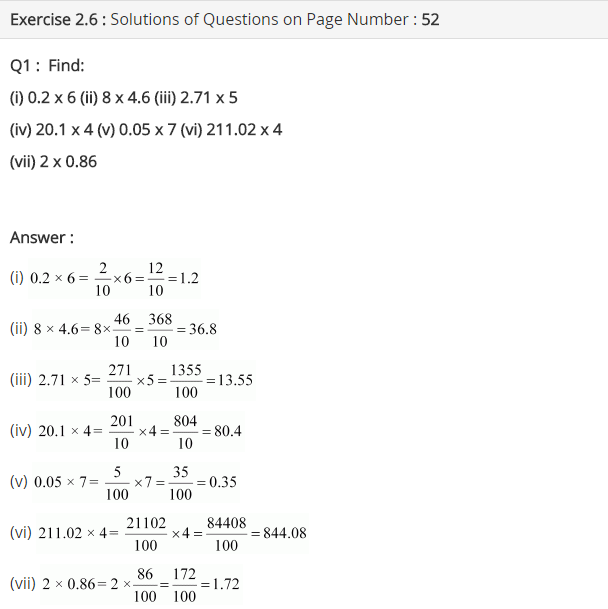
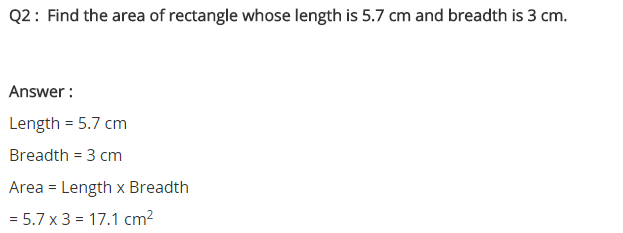
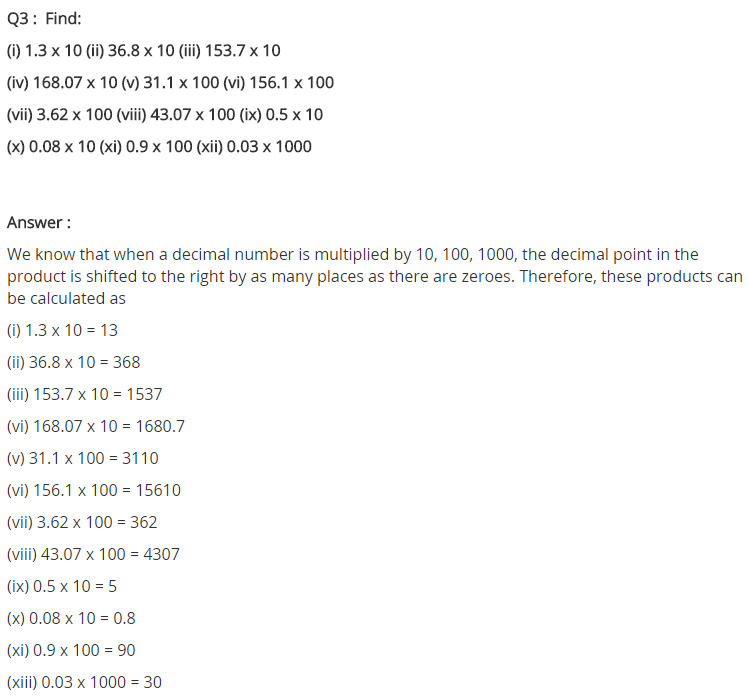



NCERT Solutions for Class 7 Maths Chapter 2 Fractions and Decimals Exercise 2.7
Ex 2.7 Class 7 Maths Question 1.
Find:
(i) 0.4 ÷ 2
(ii) 0.35 ÷ 5
(iii) 2.48 ÷ 4
(iv) 65.4 ÷ 6
(v) 651.2 ÷ 4
(vi) 14.49 ÷ 7
(vii) 3.96 ÷ 4
(viii) 0.80 ÷ 5
Solution: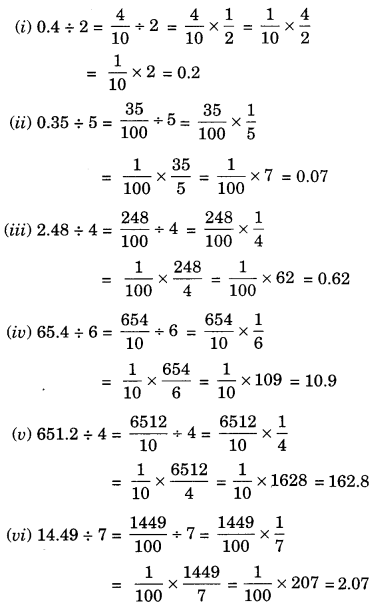
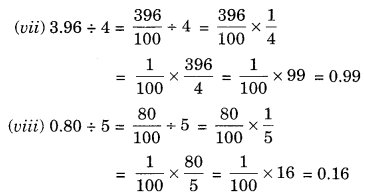
Ex 2.7 Class 7 Maths Question 2.
Find:
(i) 4.8 ÷ 10
(ii) 52.5 ÷ 10
(iii) 0.7 ÷ 10
(iv) 33.1 ÷ 10
(v) 272.23 ÷ 10
(vi) 0.56 ÷ 10
(vii) 3.97 ÷10
Solution:
(i) 4.8 ÷ 10 = 0.48 (Shifting the decimal point to the left by 1 place)
(ii) 52.5 ÷ 10 = 5.25 (Shifting the decimal point to the left by 1 place)
(iii) 0.7 ÷ 10 = 0.07 (Shifting the decimal point to the left by 1 place)
(iv) 33.1 ÷ 10 = 3.31 (Shifting the decimal point to the left by 1 place)
(v) 272.23 ÷ 10 = 27.223 (Shifting the decimal point to the left by 1 place)
(vi) 0.56 4- 10 = 0.056(Shifting the decimal point to the left by 1 place)
(vii) 3.97 ÷ 10 = 0.397(Shifting the decimal point to the left by 1 place)
Ex 2.7 Class 7 Maths Question 3.
Find:
(i) 2.7 ÷ 100
(ii) 0.3 ÷ 100
(iii) 0.78 ÷ 100
(iv) 432.6 ÷ 100
(v) 23.6 ÷ 100
(vi) 98.53 ÷ 100
Solution:
Solution:
(i) 2.7 ÷ 100 = 0.027(Shifting the decimal point to the left by 2 places)
(ii) 0.3 ÷ 100 = 0.003(Shifting the decimal point to the left by 2 places)
(iii) 0.78 ÷ 100 = 0.0078 (Shifting the decimal point to the left by 2 places)
(iv) 432.6 ÷ 100 = 4.326 (Shifting the decimal point to the left by 2 places)
(v) 23.6 ÷ 100 = 0.236 (Shifting the decimal point to the left by 2 places)
(vi) 98.53 ÷ 100 = 0.9853 (Shifting the decimal point to the left by 2 places)
Ex 2.7 Class 7 Maths Question 4.
Find:
(i) 7.9 ÷ 1000
(ii) 26.3 ÷ 1000
(iii) 38.53 ÷ 1000
(iv) 128.9 ÷ 1000
(v) 0.5 ÷ 1000
Solution:
(i) 7.9 ÷ 1000 = 0.0079 (Shifting the decimal point to the left by 3 places)
(ii) 26.3 ÷ 1000 = 0.0263 (Shifting the decimal point to the left by 3 places)
(iii) 38.53 ÷ 1000 = 0.03853 (Shifting the decimal point to the left by 3 places)
(iv) 128.9 ÷ 1000 = 0.1289 (Shifting the decimal point to the left by 3 places)
(v) 0.5 ÷ 1000 = 0.0005 (Shifting the decimal point to the left by 3 places)
Ex 2.7 Class 7 Maths Question 5.
Find:
(i) 7 ÷ 3.5
(ii) 36 ÷ 0 .2
(iii) 3.25 ÷ 0.5
(iv) 30.94 ÷ 0.7
(v) 0.5 ÷ 0.25
(vi) 7.75 ÷ 0.25
(vii) 76.5 ÷ 0.15
(viii) 37.8 ÷ 1.4
(ix) 2.73 ÷ 1.3
Solution: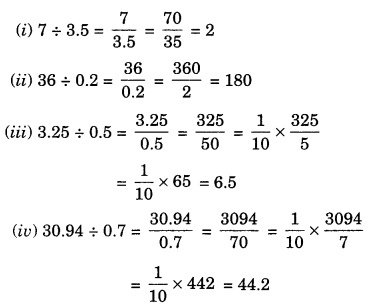
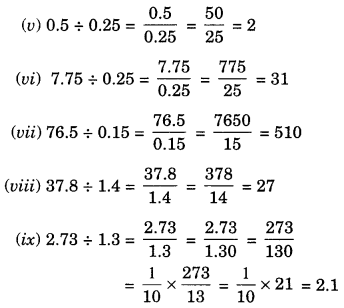
Ex 2.7 Class 7 Maths Question 6.
A vehicle covers a distance of 43.2 km in 2.4 litres of Petrol. How much distance will it cover in one litre of petrol?
Solution:
2.4 litres of petrol is required to cover 43.2 km distance
∴ 1 litre of petrol will be required to cover 43.2
Hence, the required distance = 18 km
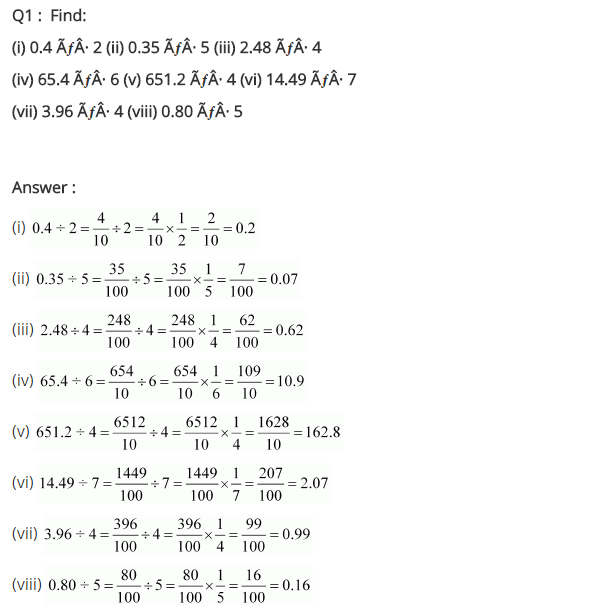
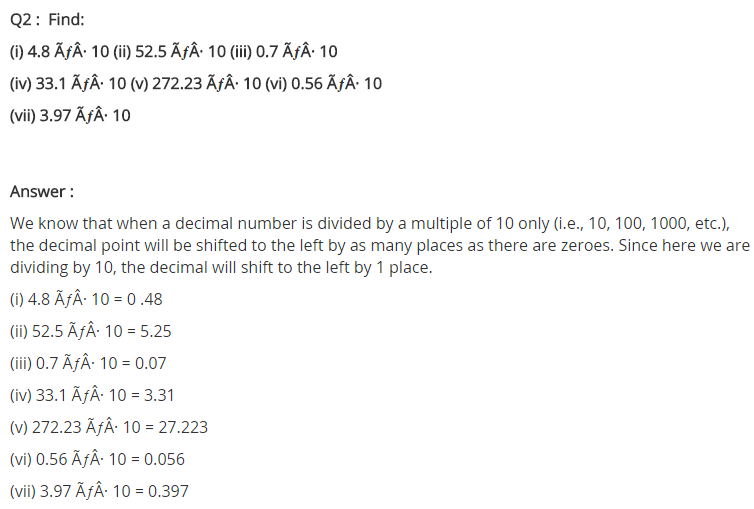
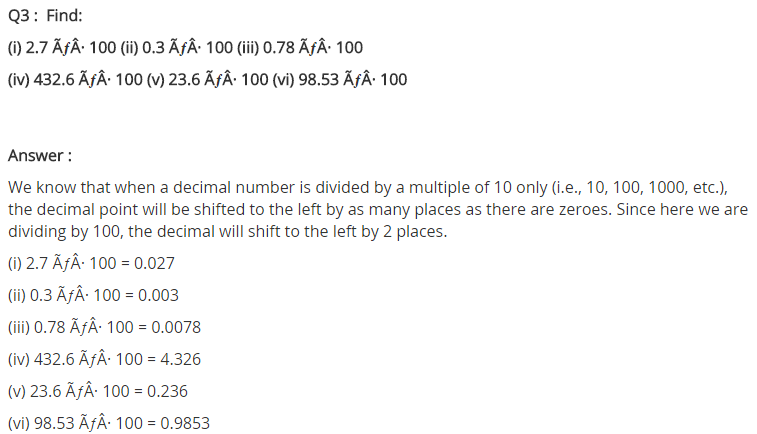
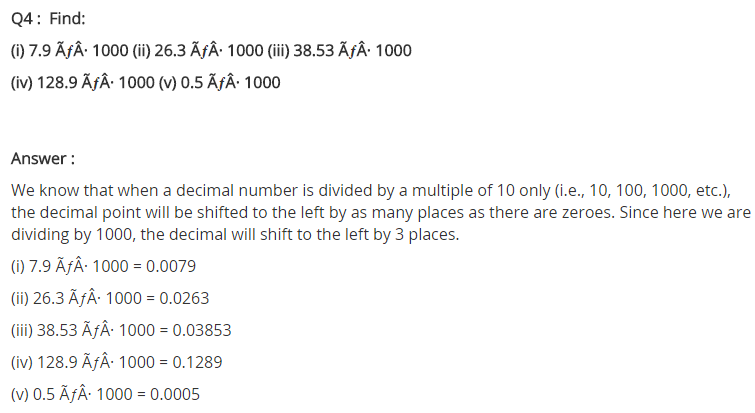
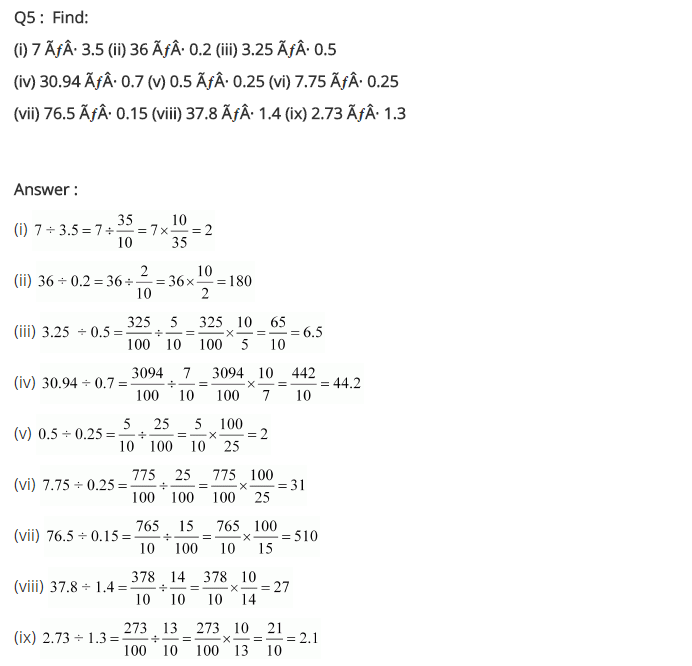

Fractions and Decimals Class 7 Extra Questions Very Short Answer Type
Question 1.
If \(\frac { 2 }{ 3 }\) of a number is 6, find the number.
Solution:
Let x be the required number.
Hence, the required number is 9.
Question 2.
Find the product of \(\frac { 6 }{ 7 }\) and 2\(\frac { 2 }{ 3 }\).
Solution:
Question 3.
Solve the following:
Solution:
Question 4.
Multiply 2.05 and 1.3.
Solution:
Fractions and Decimals Class 7 Extra Questions Short Answer Type
Question 5.
Solve the following:
(a) 3 – \(\frac { 2 }{ 3 }\)
(b) 4 + \(\frac { 2 }{ 5 }\)
Solution:
Question 6.
Arrange the following in ascending order:
Solution:

Question 7.
Find the products:
(i) 2.4 × 100
(ii) 0.24 × 1000
(iii) 0.024 × 10000
Solution:
Question 8.
Arnav spends 1\(\frac { 3 }{ 4 }\) hours in studies, 2\(\frac { 1 }{ 2 }\) hours in playing cricket. How much time did he spend in all?
Solution:
Time spent by Arnav in studies = 1\(\frac { 3 }{ 4 }\) hours
Time spent by Arnav in playing cricket = 2\(\frac { 1 }{ 2 }\) hours
Total time spent by Arnav = 1\(\frac { 3 }{ 4 }\) hours + 2\(\frac { 1 }{ 2 }\) hours
Question 9.
A square paper sheet has 10\(\frac { 2 }{ 5 }\) cm long side. Find its perimeter and area.
Solution:
Question 10.
Solution:
Question 11.
The product of two numbers is 2.0016. If one of them is 0.72, find the other number.
Solution:
Product of two numbers = 2.0016
One number = 0.72
Other number = 2.0016 ÷ 0.72
Hence, the required number = 2.78.
Question 12.
Reemu reads \(\frac { 1 }{ 5 }\)th pages of a book. If she reads further 40 pages, she would have read \(\frac { 7 }{ 10 }\)th
page of the book. How many pages are left to be read? [NCERT Exemplar]
Solution:
Let the total number of pages be x.
Number of pages read by Reemu = \(\frac { 1 }{ 5 }\)x
If she reads 40 more pages,
Total number of pages read by her = \(\frac { 1 }{ 5 }\)x + 40

Question 13.
\(\frac { 1 }{ 8 }\) of a number equals \(\frac { 2 }{ 5 }\) ÷ \(\frac { 1 }{ 20 }\). What is the number? (NCERT Exemplar)
Solution:
Let the number be x.
Hence, the required number = 64.
Question 14.
Simplify the following:
Solution:
Question 15.
The weight of an object on the Moon is \(\frac { 1 }{ 6 }\) its weight on the Earth. If an object weight 5\(\frac { 3 }{ 5 }\) kg on the Earth. How much would it weight on the Moon? [NCERT Exemplar]
Solution:
Question 16.
A picture hall has seats for 820 persons. At a recent film show, one usher guessed it was \(\frac { 3 }{ 4 }\) full, another that it was \(\frac { 2 }{ 3 }\) full. The ticket office reported 648 sales. Which usher (first or second) made the better guess? [NCERT Exemplar]
Solution:
Total number of seats = 820
Number of ticket sold = 648
For first usher = \(\frac { 3 }{ 4 }\) × 648 = 3 × 162 = 486
For second usher = \(\frac { 2 }{ 3 }\) × 648 = 2 × 216 = 432
Since 432 < 486
Hence, the first usher guessed better.
.png)
.png)